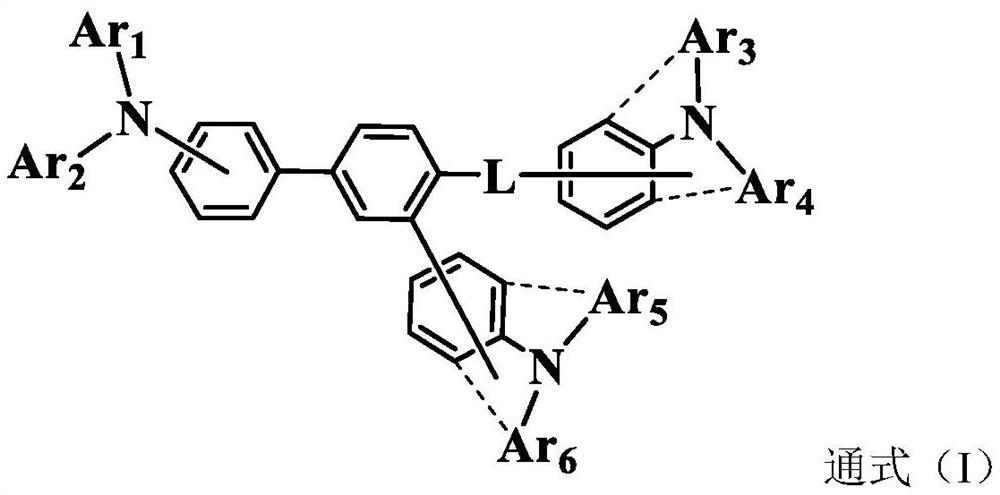Triarylamine organic compound and application thereof
An organic compound and triarylamine technology, which is applied in the field of triarylamine organic compounds, can solve different problems and achieve the effects of excellent life, excellent film phase stability and weather resistance, and excellent hole migration ability
- Summary
- Abstract
- Description
- Claims
- Application Information
AI Technical Summary
Problems solved by technology
Method used
Image
Examples
Embodiment 1
[0041] Example 1: Synthesis of Intermediate N-1
[0042]
[0043] Under a nitrogen atmosphere, add 0.02mol of raw material A-1 to a 500ml three-necked flask, add a mixed solvent (120ml toluene, 36ml H 2 O) Dissolve it, pass nitrogen and stir for 1 hour, then slowly add 0.011mol raw material B-2, 0.04molK 2 CO 3 , 0.002mol Pd (PPh 3 ) 4 , heated to 90° C., reacted for 8 hours, and observed the reaction by thin layer chromatography (TLC) until the reaction was complete. After naturally cooling to room temperature, water was added to the reaction system for extraction, the liquid was separated, and the organic phase was rotary-evaporated under reduced pressure until there was no fraction. The obtained material was purified by silica gel column to obtain Intermediate N-1 with a purity of 99.7% and a yield of 76.8%. Elemental analysis structure (molecular formula C 42 H 31 ClN 2 ): Theoretical: C, 84.19; H, 5.22; Cl, 5.92; N, 4.68; found: C, 84.11; H, 5.24; Cl, 5.93;...
Embodiment 2
[0044] Example 2: Synthesis of Intermediate N-2
[0045]
[0046] Under a nitrogen atmosphere, add 0.02mol of raw material A-1 to a 500ml three-necked flask, add a mixed solvent (120ml toluene, 36ml H 2 O) Dissolve it, pass nitrogen and stir for 1 hour, then slowly add 0.011mol raw material B-3, 0.04molK 2 CO 3 , 0.002mol Pd (PPh 3 ) 4 , heated to 90° C., reacted for 8 hours, and observed the reaction by thin layer chromatography (TLC) until the reaction was complete. After naturally cooling to room temperature, water was added to the reaction system for extraction, the liquid was separated, and the organic phase was rotary-evaporated under reduced pressure until there was no fraction. The obtained material was purified by silica gel column to obtain intermediate N-2 with a purity of 99.7% and a yield of 75.6%. Elemental analysis structure (molecular formula C 42 H 31 ClN 2 ): Theoretical: C, 84.19; H, 5.22; Cl, 5.92; N, 4.68; found: C, 84.09; H, 5.24; Cl, 5.93;...
Embodiment 3
[0047] Example 3: Synthesis of Intermediate N-3
[0048]
[0049]Under a nitrogen atmosphere, add 0.02mol of raw material C-1 to a 500ml three-necked flask, add a mixed solvent (120ml toluene, 36ml H 2 O) Dissolve it, pass nitrogen and stir for 1 hour, then slowly add 0.011mol raw material B-4, 0.04molK 2 CO 3 , 0.002mol Pd (PPh 3 ) 4 , heated to 90° C., reacted for 8 hours, and observed the reaction by thin layer chromatography (TLC) until the reaction was complete. After naturally cooling to room temperature, water was added to the reaction system for extraction, the liquid was separated, and the organic phase was rotary-evaporated under reduced pressure until there was no fraction. The obtained material was purified by silica gel column to obtain intermediate N-3 with a purity of 99.6% and a yield of 72.9%. Elemental analysis structure (molecular formula C 42 H 27 ClN 2 ): Theoretical: C, 84.76; H, 4.57; Cl, 5.96; N, 4.71; found: C, 84.69; H, 4.59; Cl, 5.97; ...
PUM
| Property | Measurement | Unit |
|---|---|---|
| thickness | aaaaa | aaaaa |
Abstract
Description
Claims
Application Information
 Login to View More
Login to View More - R&D
- Intellectual Property
- Life Sciences
- Materials
- Tech Scout
- Unparalleled Data Quality
- Higher Quality Content
- 60% Fewer Hallucinations
Browse by: Latest US Patents, China's latest patents, Technical Efficacy Thesaurus, Application Domain, Technology Topic, Popular Technical Reports.
© 2025 PatSnap. All rights reserved.Legal|Privacy policy|Modern Slavery Act Transparency Statement|Sitemap|About US| Contact US: help@patsnap.com



